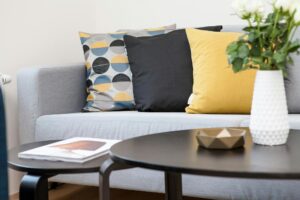
Office Space
Home decorating is an exciting journey that allows you to express your personality and create a space that feels uniquely yours.
In Kenya, where vibrant cultures and breathtaking landscapes inspire creativity, home decor can reflect the rich heritage and beauty of the environment. This blog explores various home decorating ideas that incorporate local elements, making your living space not just beautiful but also meaningful.
1. Embrace African Textiles
Kenya boasts a rich tradition of textile craftsmanship. Incorporating local fabrics such as kanga, kikoi, and shuka into your decor can add color and texture to your home. Here are a few ideas on how to use these textiles effectively:
- Cushion Covers: Transform your living room by using vibrant kanga or kikoi fabric for cushion covers. These textiles come in various patterns and colors, allowing you to mix and match to create a lively atmosphere.
- Table Runners and Curtains: Use shuka fabric as table runners for dining tables or curtains for windows. This approach not only adds a cultural touch but also introduces beautiful, warm colors into your space.
- Wall Hangings: Create striking wall art by framing pieces of colorful textiles. This method provides a unique visual element and pays homage to Kenyan craftsmanship.
2. Incorporate Local Art
Art plays a crucial role in Kenyan culture, with talented artists producing stunning pieces that tell stories of tradition, nature, and life. Integrating local art into your home decor can enhance the aesthetic and create a conversation starter.
- Sculptures: Look for wooden or soapstone sculptures that represent Kenyan wildlife or traditional figures. Place these sculptures on shelves, coffee tables, or mantels to add a three-dimensional aspect to your decor.
- Paintings: Hang paintings by local artists that depict vibrant landscapes, traditional scenes, or abstract interpretations of Kenyan culture. This approach can brighten up your walls and bring a sense of local identity to your home.
- Crafts: Consider incorporating handmade crafts such as beaded items, woven baskets, or pottery. These pieces add texture and a personal touch to any room.
3. Use Natural Elements
Kenya’s stunning landscapes provide ample inspiration for incorporating natural elements into your home. Bringing the outdoors in creates a refreshing and calming environment.
- Indoor Plants: Fill your home with indigenous plants such as the aloe vera, snake plant, or peace lily. These plants not only purify the air but also add a touch of greenery to your decor.
- Natural Materials: Utilize materials such as wood, stone, and clay in your furniture and decor. For instance, choose wooden coffee tables or stone decorative items to enhance the earthy feel of your home.
- Bamboo and Rattan: Consider using bamboo or rattan furniture for a light and airy look. These materials are sustainable and bring a touch of nature into your interior spaces.
4. Create a Cozy Outdoor Space
Kenyan weather encourages outdoor living, making it essential to create inviting outdoor spaces. Design your patio, balcony, or garden to extend your living area and enjoy the beautiful climate.
- Outdoor Seating: Invest in comfortable outdoor furniture, such as woven chairs and benches. Add colorful cushions made from local textiles to create a cozy seating area.
- Fire Pit or Barbecue: Incorporate a fire pit or barbecue station for evening gatherings. This addition encourages socializing and enhances your outdoor experience.
- Lanterns and String Lights: Use lanterns and string lights to create a warm ambiance in your outdoor space. These lighting options are perfect for evening entertaining.
5. Highlight Kenyan Colors
Kenyan landscapes are rich in color, from the vibrant greens of the savannah to the warm browns of the earth. Incorporating these colors into your home can create a harmonious and inviting atmosphere.
- Accent Walls: Choose an accent wall in earthy tones like terracotta or olive green. These colors evoke the beauty of Kenya’s landscapes and can serve as a backdrop for your decor.
- Colorful Accessories: Use colorful accessories like vases, rugs, and artwork to bring life to neutral spaces. Look for items in bright reds, yellows, and blues that reflect the vibrancy of Kenyan culture.
- Mixed Patterns: Don’t shy away from mixing patterns in your decor. Combining different African prints can create a dynamic and visually appealing space.
6. Integrate Functional Decor
In Kenyan homes, functionality often blends seamlessly with decor. Embrace this approach by choosing items that serve dual purposes.
- Storage Solutions: Opt for decorative baskets or storage ottomans that provide both storage and style. These items keep your space organized while adding texture to your decor.
- Multi-Functional Furniture: Invest in furniture pieces that can serve multiple functions, such as a coffee table with storage or a bench that doubles as seating and storage. This strategy maximizes space and enhances functionality.
- Decorative Hooks: Use decorative hooks for hanging items like hats, bags, or kitchen utensils. These hooks can be stylishly integrated into your wall decor, providing practical storage solutions.

7. Showcase Family Heritage
Incorporating family heritage into your home decor adds a personal touch and connects you to your roots. Consider these ideas:
- Family Gallery Wall: Create a gallery wall featuring family photos, traditional artifacts, or heirlooms. This wall serves as a tribute to your family’s history and adds a personal narrative to your space.
- Cultural Memorabilia: Display items that reflect your family’s culture or history, such as traditional crafts or awards. These items serve as conversation starters and showcase your unique background.
- Storytelling Elements: Use decor items that tell a story about your family’s journey or culture. This approach deepens the emotional connection to your space.
8. Personalize Your Space
Personalization is key to making your home feel inviting and comfortable. Tailor your decor to reflect your interests and style.
- Hobbies and Interests: Display items related to your hobbies, such as musical instruments, books, or art supplies. Showcasing these items adds character and speaks to your passions.
- Travel Mementos: Incorporate souvenirs from your travels into your decor. This approach adds a global touch and allows you to share your experiences with guests.
- Seasonal Decor: Change your decor with the seasons to keep your space feeling fresh. Rotate accessories, colors, and themes to reflect different times of the year.
9. Maintain Balance and Harmony
Creating a harmonious space involves balancing different elements in your decor. Aim for a cohesive look by considering the following:
- Consistent Color Palette: Choose a color palette that reflects your style and use it consistently throughout your home. This consistency creates a cohesive and inviting atmosphere.
- Balanced Furniture Arrangement: Arrange your furniture to promote flow and conversation. Ensure that larger pieces do not overwhelm smaller items, creating a balanced look.
- Layering Textures: Mix and match textures to create depth in your decor. Use soft fabrics, natural materials, and smooth finishes to achieve a harmonious balance.
Conclusion
Home decorating is a personal journey that allows you to express your style and create a sanctuary that resonates with you. By incorporating local elements, embracing Kenyan culture and showcasing your individuality, you can transform your living space into a beautiful reflection of who you are.
With these ideas, you can create a warm, inviting home that celebrates the rich tapestry of Kenyan life, making your decor not only stylish but also meaningful. Whether you’re starting from scratch or looking to refresh your existing space, these tips will help you cultivate a home that feels distinctly Kenyan, vibrant, and full of life. Enjoy the process of decorating, and let your creativity shine!







